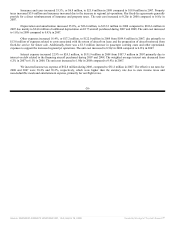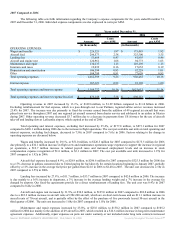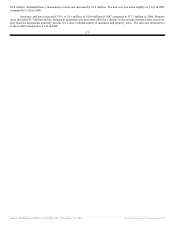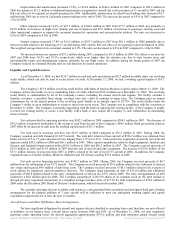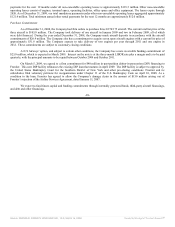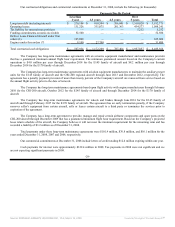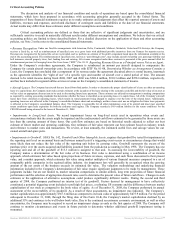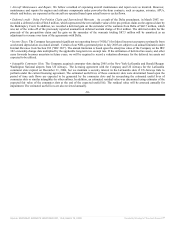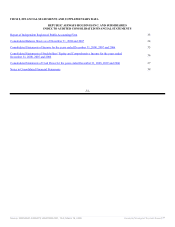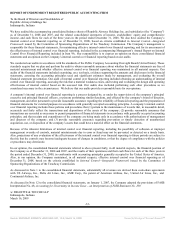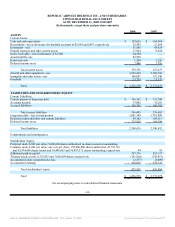Frontier Airlines 2008 Annual Report Download - page 56
Download and view the complete annual report
Please find page 56 of the 2008 Frontier Airlines annual report below. You can navigate through the pages in the report by either clicking on the pages listed below, or by using the keyword search tool below to find specific information within the annual report.
Critical Accounting Policies
The discussion and analysis of our financial condition and results of operations are based upon the consolidated financial
statements, which have been prepared in accordance with accounting principles generally accepted in the United States. The
preparation of these financial statements requires us to make estimates and judgments that affect the reported amount of assets and
liabilities, revenues and expenses, and related disclosure of contingent assets and liabilities at the date of our financial statements.
Actual results may differ from these estimates under different assumptions and conditions.
Critical accounting policies are defined as those that are reflective of significant judgments and uncertainties, and are
sufficiently sensitive to result in materially different results under different assumptions and conditions. We believe that our critical
accounting policies are limited to those described below. For a detailed discussion on the application of these and other accounting
policies, see Note 2 in the notes to the consolidated financial statements.
• Revenue Recognition. Under our fixed-fee arrangements with American, Delta, Continental, Midwest, Mokulele, United and US Airways, the Company
receives a fixed-fee, as well as reimbursement of specified costs on a gross basis with additional possible incentives from our Partners for superior service.
Revenues are recognized in the period the service is provided, and we perform an estimate of the profit component based upon the information available at the
end of the accounting period. The reimbursement of specified costs, known as “pass-through costs”, may include aircraft ownership cost, passenger liability and
hull insurance, aircraft property taxes, fuel, landing fees and catering. All revenue recognized under these contracts is presented at the gross amount billed for
reimbursement pursuant to Emerging Issues Tax Force Issue (“EITF”) No. 99-19 Reporting Revenue Gross as a Principal versus Net as an Agent.
Under the Company’s code-share agreements, the Company is reimbursed an amount per aircraft designed to compensate the
Company for certain aircraft ownership costs. In accordance with EITF No. 01-08, Determining Whether an Arrangement Contains a
Lease, the Company has concluded that a component of its revenue under the agreement discussed above is rental income, inasmuch
as the agreement identifies the “right of use” of a specific type and number of aircraft over a stated period of time. The amount
deemed to be rental income during fiscal 2008, 2007 and 2006 was $348.4 million, $310.3 million and $258.6 million, respectively,
and has been included in regional airline services revenue on the Company’s consolidated statements of income.
• Aircraft Leases. The Company has aircraft that are leased from third parties. In order to determine the proper classification of a lease as either an operating
lease or a capital lease, the Company must make certain estimates at the inception of the lease relating to the economic useful life and the fair value of an asset as
well as select an appropriate discount rate to be used in discounting future lease payments. These estimates are utilized by management in making computations
as required by existing accounting standards that determine whether the lease is classified as an operating lease or a capital lease. All of the Company’s aircraft
leases have been classified as operating leases, which results in rental payments being charged to expense over the term of the related leases. Additionally,
operating leases are not reflected in the Company’s consolidated balance sheet and accordingly, neither a lease asset nor an obligation for future lease payments
is reflected in the Company’s consolidated balance sheet. The Company is responsible for all other maintenance costs of its aircraft and must meet specified
return conditions upon lease expiration for both the airframes and engines. The Company recorded a $4.9 million liability for the return conditions for the
CRJ-200 aircraft being returned to the lessor at December 31, 2008.
• Impairments to Long-Lived Assets. We record impairment losses on long-lived assets used in operations when events and
circumstances indicate that the assets might be impaired and the undiscounted cash flows estimated to be generated by those assets are
less than the carrying amount of those items. Our cash flow estimates are based on historical results adjusted to reflect our best
estimate of future market and operating conditions. Our estimates of fair value represent our best estimate based on industry trends
and reference to market rates and transactions. We review, at least annually, the estimated useful lives and salvage values for our
owned aircraft and spare parts.
• Impairments to Goodwill. SFAS No. 142, Goodwill and Other Intangible Assets, requires that goodwill be tested for impairment at
the reporting unit level on an annual basis and between annual tests if a triggering event occurs or circumstances change that would
more likely than not reduce the fair value of the reporting unit below its carrying value. Goodwill represents the excess of the
purchase price over the assets acquired and liabilities assumed from the push-down accounting in May 1998. The Company has one
reporting unit and all of the goodwill of $13.3 million is assigned to that unit. In assessing the recoverability of goodwill, the
Company makes a determination of the fair value of its business. Fair value is determined using a combination of an income
approach, which estimates fair value based upon projections of future revenues, expenses, and cash flows discounted to their present
value, and a market approach, which estimates fair value using market multiples of various financial measures compared to a set of
comparable public companies in the regional airline industry. An impairment loss will generally be recognized when the carrying
amount of the net assets of the business exceeds its estimated fair value. The valuation methodology and underlying financial
information included in the Company’s determination of fair value require significant judgments to be made by management. These
judgments include, but are not limited to, market valuation comparisons to similar airlines, long term projections of future financial
performance and the selection of appropriate discount rates used to determine the present value of future cash flows. Changes in such
estimates or the application of alternative assumptions could produce significantly different results. During the second and third
quarter of 2008, the Company performed an interim test of its goodwill. Factors deemed by management to have collectively
constituted a potential triggering event included record high fuel prices, a softening US economy and the differences between market
capitalization of our stock as compared to the book value of equity. As of December 31, 2008, the Company performed its annual
assessment of the recoverability of its goodwill. As a result of these assessments, no impairment was indicated. The Company’s
market capitalization was approximately $367.6 million as compared to its book value of approximately $475.9 million. For the period
subsequent to December 31, 2008, through the filing date of this Form 10-K, the Company's market capitalization declined by an
additional 55% and continues to be well below book value. Due to the continued recessionary economic environment, as well as other
uncertainties, the Company may be required to record an impairment charge as early as the first quarter of 2009. The Company will
continue to monitor circumstances and events in future periods to determine whether additional goodwill impairment testing is
warranted.
Source: REPUBLIC AIRWAYS HOLDINGS INC, 10-K, March 16, 2009 Powered by Morningstar® Document Research℠






